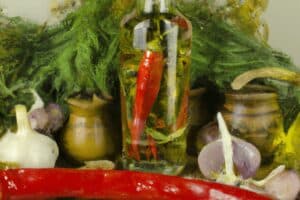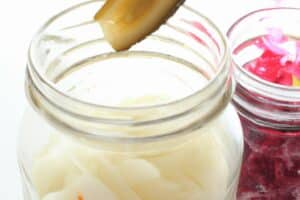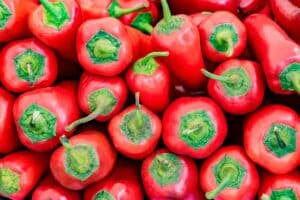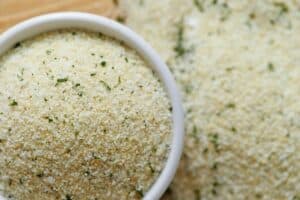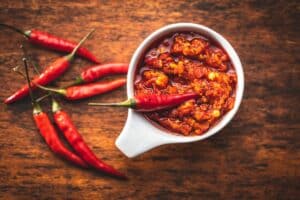While there are numerous scallion substitute, we have narrowed the list down to the five best options: Yellow onions, chives, leeks, shallots, and spring onions. These five scallion alternatives are readily available in the produce section of supermarkets nationwide.
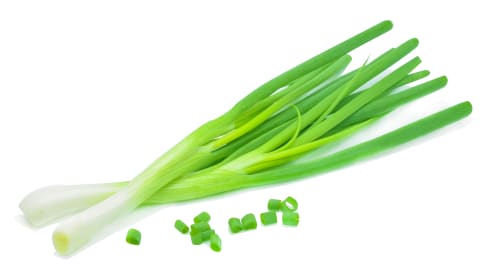
What Are Scallions Made Of?
Scallions, also known as green onions, are a member of the family Allium, as are most onions and garlic species, including all the substitutes on our list. Scallions consist of a long, deep green stalk and a small white bulbous root, both of which are used in cooking.
A scallion’s green stalk delivers a subtle yet aromatic flavor and is best used raw, while the white bulb has a stronger oniony taste and lends well to frying or sautéing. Scallions, like all onions, are a ubiquitous staple in most dishes as they greatly contribute to the flavor profile, adding richness, sweetness, and a nice bite both in terms of texture and spice.
Their deep, vibrant green stalks are great garnishes for any dish, from soups to dips, dressings to baked potatoes, nachos to chili, and everything in between.
Apart from being fundamental flavor bases for dishes cross-culturally, scallions have excellent health benefits for our bodies and immune systems. They supply hefty amounts of fiber, antioxidants, cancer-fighting compounds called allicin, and anti-bacterial/fungal/viral properties.
Recommended Scallion Substitute
Substitute adequacy depends on what part of the scallion you want to replace and whether you need raw garnishes or cooked bulbs.
1. Yellow Onions
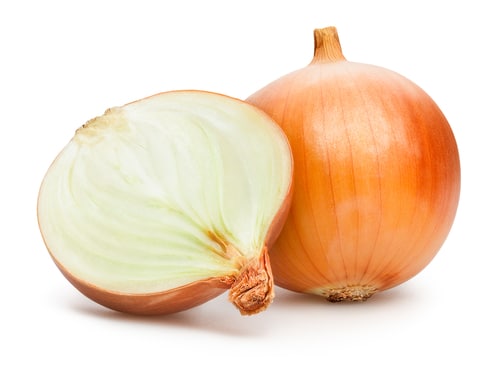
Yellow onions, or sweet onions, are a staple you’re likely to always have in your kitchen because it is the base of most soups, stir-fries, and stews. Of the large onions, the yellow onion is a better substitute than the red or white variations because they are sweeter and less pungent, thereby more aptly resembling the mild scallion.
That said, sweet onions are much stronger in flavor and smell than scallions, so sweet onions are better substitutes for scallions in dishes that require them to be cooked.
You can use equal amounts of diced yellow onions to replace the white parts of scallions in cooked dishes, but if you want to replace the stalk, it’s important to dice the yellow onion as finely as possible and use it in much smaller proportions.
A trick to rid the yellow onion of its aromatic pungency is to cut the raw onion in half and soak it in ice water for around 15-20 minutes before dicing it. While they may not be the ideal topping for fried rice or ranch dip, you can use them as toppings on bolder and heavier dishes like nachos or meat and bean chilis.
Yellow onions are the cheapest, most widely available scallion substitute on our list, and they also have the longest shelf life. You don’t even have to store them in the fridge before cutting them. Depending on the climate, yellow onions can last for a month or more if stored in a cool, dry pantry drawer.
Can’t find yellow onions? Red onions might be a good alternative.
2. Chives

If you don’t know the difference between chives and scallions, you’d be in the majority. Plus, the fact that you thought they were one in the same means they are probably the best substitute for scallions. The main difference between chives and scallions is that chives are used as a leafy herb while scallions have various uses in cooking.
Other than their culinary uses, chives also serve as decorative plants in landscaping as their green stalks flower with a lilac-colored bud. They’re also used to control pests as their smell acts as a repellent.
Chives have a subtler flavor than scallions and a softer texture to their stalks but are indistinguishable from scallions when used as a garnish or topper. They must be used raw, as cooking them will diminish their flavor and therefore nullify their use as a foundational ingredient.
You can add them to fried rice, soups, scrambled eggs, salads, dips, or herb butter for a burst of color and a light flavor enhancer. They are more delicate than scallions, so make sure you use a sharp knife or scissors to dice them to avoid bruising.
To ensure they stay fresh and do not dry out, the best way to store them is by enveloping chive stalks in a damp paper towel and placing them above heavier vegetables in the vegetable crisper drawer in the fridge.
3. Spring Onions
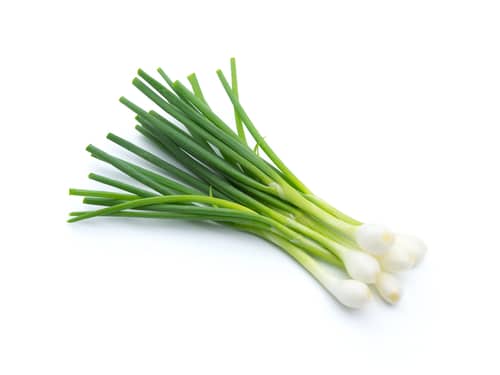
Spring onions are premature versions of large white onions, harvested before the bulbs reach their adult sizes. Spring onions stalks and bulbs are very similar in flavor and texture to scallions, although their bulbs often have a purplish striping to their outer skins.
You can substitute scallion stalks or bulbs with spring onions in the same proportions in any dish. Their bulbs may be slightly more pungent than scallion bulbs, and their stalks tend to get tougher with age. Therefore, you should ensure that the spring onions look as fresh and young as possible before purchasing them from the store.
The bulbs may be more pungent, but they will sweeten to scallion-like subtlety the longer you sautee them. You can use the bulbs sauteed in Spanish omelets or frittatas, Asian-style stir-fries, or stewed sauces.
Spring onion stalks taste great and are as vibrant in color as scallions, making them perfect toppers and garnishes for nachos, dips, rice, and potato salads.
4. Leeks
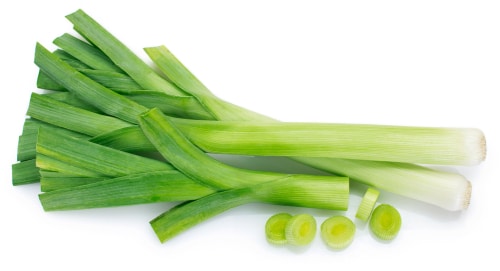
Leeks appear to be scallions on steroids, their long green stalks opening out to a characteristic fan-shaped end. Additionally, their bottom ends have stringy roots but no bulbous base. They are a bit more labor-intensive to clean and cut because you don’t use the darker green stalks and must remove the outer layer to expose a light green layered center.
Leeks’ light green and white center is the only usable part and is the sweetest tasting of all the allium family. Leeks impart a wonderfully sweet and much less oniony flavor to any cooked dish, but they don’t work well raw.
Leeks’ sweetness is unleashed upon frying or sauteing them, so using them as a raw garnish doesn’t showcase their excellent flavor, nor will you enjoy their tough, chewy raw texture. Consequently, leeks are better substitutes for scallions if you need to replace the bulbs.
Leeks keep longer than scallions, spring onions, and chives due to their tough inedible outer stalks, and you don’t need as much of them to bring a great underlying flavor to soups, risottos, and meat-heavy main dishes.
5. Shallots
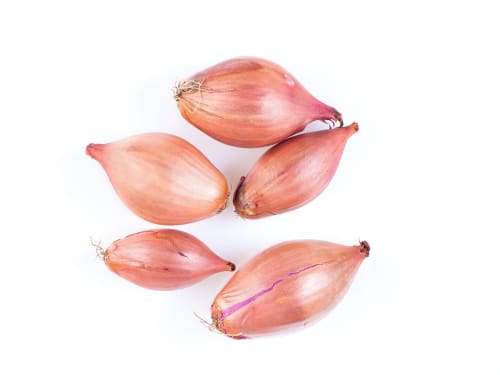
Shallots are also a member of the allium family and look like a cross between an onion and a garlic bunch as they look like large garlic cloves composed of red onion layers. They have a much milder and more delicate flavor than large onions, yet still stronger than a scallion bulb. They taste great, both raw and cooked.
While they do not add color to the dish, their utility as flavor substitutes in dressings, salads, stews, sauces, and stir-fries is excellent. They may be harder to find and slightly more expensive than the other onions on our list, though.
FAQs
Scallions are members of the onion and garlic family, and therefore have an onion flavor that is more pronounced in their white bulbs. Their deep green stalks have a subtle onion flavor and serve more as a colorful garnish than a flavor infuser.
While their green stalks are used mainly as a garnish, their bulbs lend well to frying and sauteing.
Scallions have a more pungent flavor and larger bulbs, while chives are softer, leafier, and milder onion grasses used primarily as an herb.
The two best methods to store scallions so that they maintain their freshness and crispness are:
1. Place the scallions upright with their bulbs in a receptacle with 1-2 inches of water in the refrigerator.
2. Wrap the scallions in damp paper towels and place them inside a zip-lock back in your refrigerator’s crisping drawer.
If left at room temperature, scallions can last from 2-4 days, but placing them in the refrigerator increases their longevity up to about ten days. Their bulbs have a longer life than their stalks.


